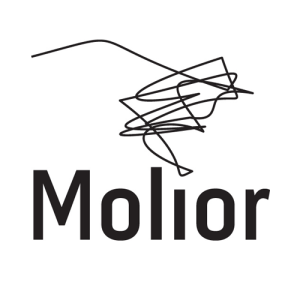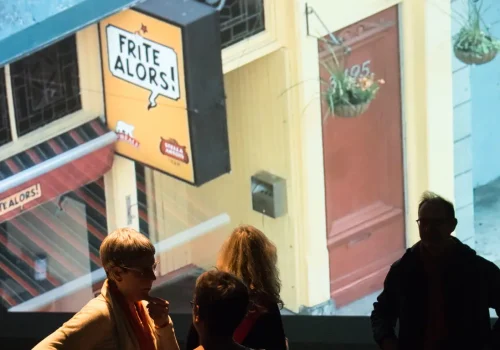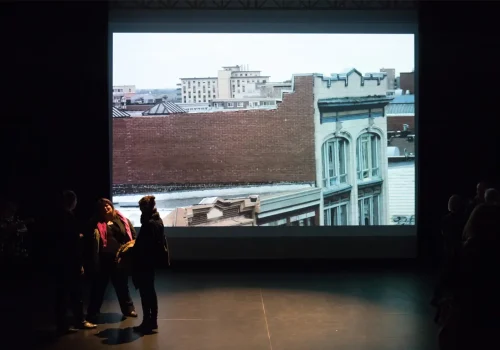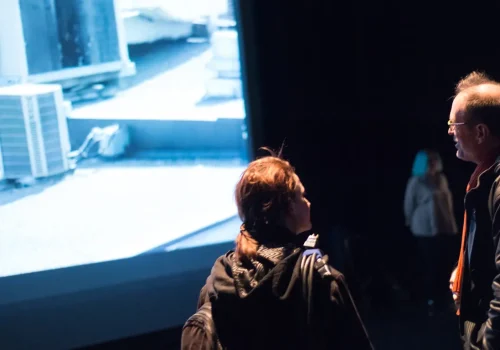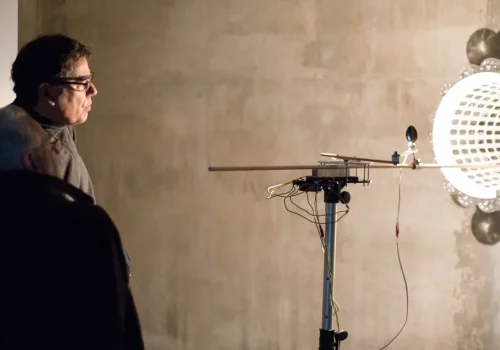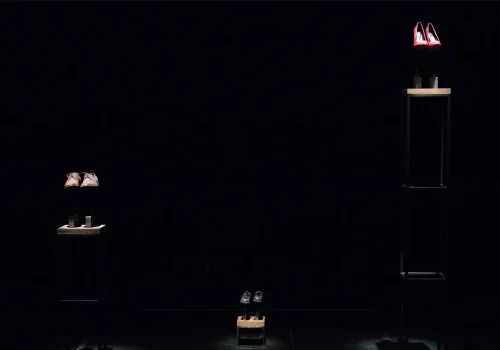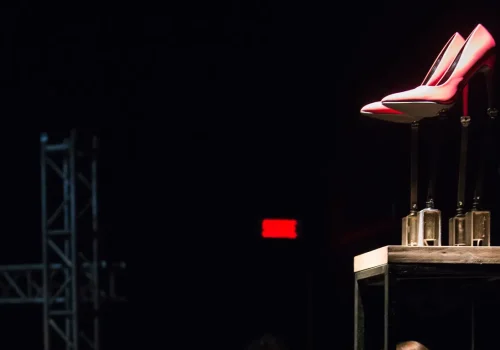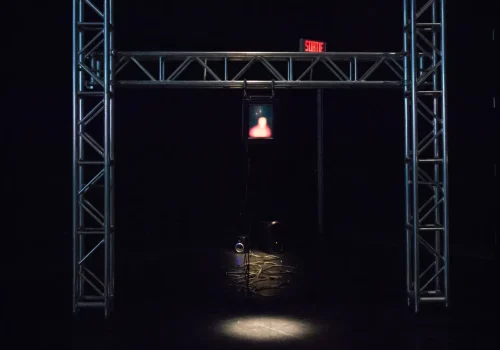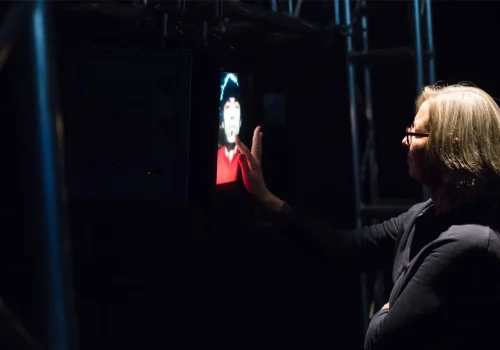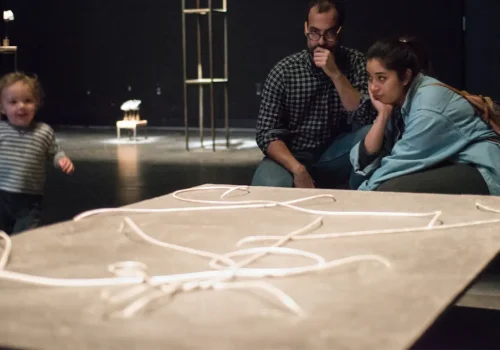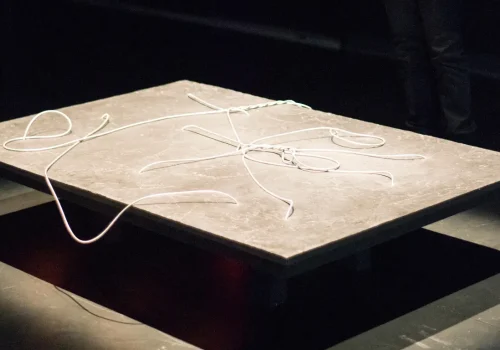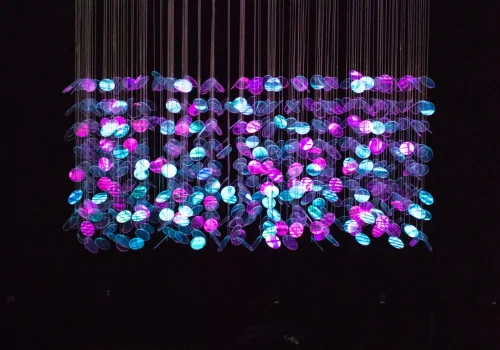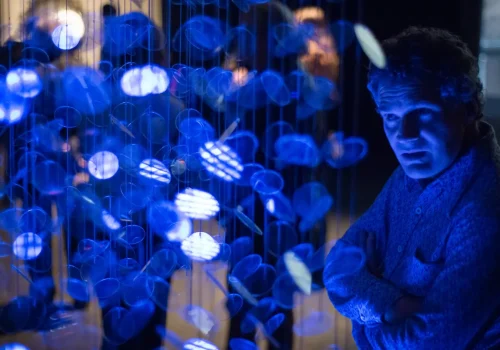Rhythms of the Imagination, Technological Tools and Works
Montreal, Canada
From November 10th to November 19th, 2016
Curator
Marie Perreault
As part of the events surrounding Molior’s 15th anniversary, the exhibition focuses on the works of artists who develop and appropriate technology, such as it as been brought to view by the organization’s activities over the last fifteen years.
The first intuition for the exhibition was triggered by a major research project led by Greg Lynn at the Canadian Centre for Architecture about the impact of the digital on architecture, both on the production and the final works and on the conservation of works presenting a challenge for museum institutions. The dynamism of Quebec’s digital art scene over the years is also worthy of a systematic study by way of an examination of the whys and wherefores of its emergence, its development and its incorporation in the contemporary art field.
However, the anniversary of a dissemination organization like Molior does not seem to be the appropriate occasion to do so, though we nevertheless hope to soon have the opportunity to take up this task. Meanwhile, a look back at its activities highlights the work components that it has given priority to and defended over the years, and an examination of the works’ exhibition history, including their acquisition by private collectors or museum institutions, makes it possible to understand the specificities of disseminating contemporary digital art and to identify current and future challenges.
Molior’s activities were initially based on the presentation of works by one or two artists, often working outside the established networks, but they rapidly developed into curatorial propositions, in collaboration with dissemination partners, both locally and internationally, thus opening its events to other networks beyond those specifically dedicated to digital art, a niche sector that these works are no longer necessarily confined to.
In this context the works selected by Andrée Duchaine, the founder of Molior, and Sylvie Parent, a guest curator and subsequently the organization’s artistic director from 2009 to 2014, and by other occasional collaborators, opened ways of thinking that went beyond the at times spectacular effect of technology. There propositions were more rooted in a reflection on the role of digital tools in our lives, as well as their structuring and dynamic action in a reciprocal relationship, in other words their agency. In this regard, the body, interactivity, spatial perception and duration emerged as favoured aspects of the production; the works gathered here respect this stance.
As part of the presentation of À l’intérieur/Inside at the Third Beijing International New Media Arts Exhibition and Symposium in China in 2006, Sylvie Parent selected the work Tact (2001) by Jean Dubois. As in the work Syntonie, exhibited here, this interactive video unfolds on a touch-screen interface that facilitates an encounter between a viewer and a character. In Tact, in reaction to the viewer’s tentative steps, the face of a woman becomes more defined and freezes as it squashes against the inner surface of a touch-screen embedded in a round mirror, thus exposing her to our exploratory gestures. In Syntonie, also from 2001, the gestures trigger a more narrative interaction that is not limited to an encounter brought about by the touch-screen interface, since it prompts the protagonist to make inviting gestures and expose some parts of his body in a game of erotic allusions. Moreover, the display apparatus underlines the general set up of the technical relays, notably the cables and the computer tower, which support this exchange but are in contradiction with its intimate nature.
Likewise taking an interest in the body, Ingrid Bachman showed Symphony for 54 Shoes (Distant Echoes) as part of B/R/T Le corps habité curated by Andrée Duchaine in Montréal in 2007, the same year that the work was created. By way of a mechanism, the artist here animates a set of 27 pairs of used shoes to a random rhythm controlled by a computer. The everyday movements that wore out these shoes are echoed by an absurd mechanical activity that results in an unusual sound choreography. In Family (Anxious State) shown here, the shoes’ movements intervene in reaction to the viewer’s movements, thus creating an equally strange sound ambiance, but they more directly evoke the role of the individual in a group and the at times ambiguous ties linking members of the same family.
The work Stressato: Samouraï Serpents (2010) by Jean-Pierre Gauthier, presented by Sylvie Parent at the FILE festival in São Paul in 2012, is part of a similar viewer-activated sound register. As the curator states, the recourse to movement introduces new behaviours into the material world and endows matter and ordinarily immobile things with a dynamism, thereby associating them with living things, notably in regards to elements that escape our control. In this sense, the work has a disquieting character. Despite the playful aspects, the use of technology awakens, or rather reveals our anxieties before a world that appears to be in the hands of a sorcerer’s apprentice. It thereby embodies both the promises and threats that are often attributed to digital technology and tools.
On an entirely different note, as in Chevalier de la résignation infinie (2009) presented by Molior in 2011, Mandala Naya of the series Le déclin bleu (2002) by Diane Landry creates a play of shadows and lights that induces a state of meditative contemplation. The circular movement of a mechanism here moves a light source to the centre of a laundry basket lined by empty plastic bottles. The shadows and light interferences created by these objects alternately unfold and retreat to a meditative rhythm in keeping with the overall composition which imitates a mandala. The motor’s perpetual movement refers to a different perception of time, one that points to a spiritual dimension. In this context, technology, the laundry basket and the empty bottles stimulate reflection on our everyday life, the place that the machine plays in it and our routines, as well as on the reduction of personal satisfaction to consumerism.
Furthermore, Molior’s various projects have also addressed the issue of our surroundings’ computerization. Luc Courchesne’s Sublimations: Homme-Femme (2014), also selected here, refers to this media environment. Between an LCD screen suspended from the ceiling and another one placed on the floor, plastic disks reflect coloured swarms of changing images of men and women. Sublimation here both refers to the transformation of the men’s and women’s respective bodies into evanescent ethereal displays and to the diversion of the sex drive, recalling the workings of advertisement. Contrary to the interactive portraits of his early career, Luc Courchesne here focuses on the opacity of the communication media. In addition, the display recreates the immersive effect of the artist’s other media environments and associates mass communication with the panoramas that these works unfold, thus inviting us to also reflect on this reality.
Much like Diane Landry’s, Machine for Taking Time by David Rokeby also has an evident meditative character that is buttressed by the fade-in-fade-out of images, randomly selected in databases built up with the input of two cameras respectively scanning Montreal towards the east and the west. The city panorama is expanded through references to various moments of the day over the course of the seasons, which modulates the colour and texture of the image. This reference to natural cycles evokes a different timeframe, one that is inscribed in the constancy of duration and is the opposite of mass communication’s media effervescence that the ambition to grasp everything from the originary device represents. The allusion to this profusion and to our image-obsessed society is also at work in Taken (2002) shown by Molior in 2007 and 2008.
Furthermore, as an introduction to the colloquium, organized as part of Molior’s 15th anniversary celebrations, exploring the specificities of disseminating contemporary digital art, the exhibition and acquisition history of the works constitutes a concrete of example of their singular path, one that is distinct from the traditional artistic path. However, preparatory research revealed that over the years large institutions have increasing made acquisitions of works with a technological component and that private collectors are also taking an interest in this art form. The works Mandala Naya by Diane Landry and Machine for Taking Time belong to museum institutions, the first to the Musée national des beaux arts du Québec since 2008, and the second was recently acquired by the National Gallery of Canada. For its part, Luc Courchesne’s work is part of the collection of Debbie Zakaïb and Alexandre Taillefer. Digital art is thus no longer confined to specialized events, on the basis of their technical components or specificity. In fact, works that involve technology form an important part of contemporary art and are now incorporated, even recognized, on equal footing with other practices by institutional exhibitions.
In regard to the development of tools, software or technology, or prototypes, which are an integral part of digital artwork production, the history and conservation of these works remains singular, particularly due to the eminently variable character of their display. This is the case for Syntonie by Jean Dubois, which adapts itself in a very particular way to its presentation context. Likewise, the work Family Anxious State by Ingrid Bachmann is also displayed in separate parts or as a prototype. The series Le Déclin Bleu by Diane Landry comprises a monotype of Mandala Labrador and an edition of three of Mandala Naya and Mandala Perrier. For its part, Machine for Taking Time by David Rokeby is embodied in another iteration, which has a different database, in such a way that the artist’s signature applies both to the apparatus under development as to the final work. The interactive installations, such as Taken by Rokeby also required monitoring software development and video processing, which are put up for sale on his website.
All these examples speak to the necessity to hold the colloquium that will follow this exhibition and set off another cycle of independent activity for Molior.
[Marie Perrault, curator]
Marie Perreault
Critique et commissaire, elle a réalisé au cours des 20 dernières années plusieurs expositions en art contemporain et signé de nombreux essais pour des revues spécialisées et des catalogues.
Elle s’intéresse à l’impact des technologies sous un angle anthropologique et sociologique, ainsi qu’à différents aspects de l’art public. Elle assure également la direction artistique du Symposium de Baie-Saint-Paul.
Marie Perrault a été chargée de projet pendant plus de douze ans au Service d’intégration des arts à l’architecture du ministère de la Culture et des Communications du Québec. Elle a été directrice du Centre international d’art contemporain.
Artists & works
David Rokeby
Machine for Taking Time
Description
Commissioned by the Fondation Daniel Langlois, on the occasion of its 10th anniversary, the work consists of a database made up of a 1024 images per day, captured by each of the cameras that respectively scan the east and west of Montreal from the rooftop of the Foundation on rue Saint-Laurent. Altogether the project comprises over 750,000 images, randomly projected and mixing moments of the day and the seasons, which thus confront us with the passage of time. The use of a database recalls the work Taken shown by Molior, in Transitions/Transiciones in Lima, Peru in 2007 and SYNTHETIC TIMES – Media art China in 2008. In 2016, the National Gallery of Canada acquired an edition of Machine for Taking Time, which was reworked for the occasion.
Biography
David Rokeby creates interactive installations that react to the presence of the viewer or explore the potential of the database. His works also comprise interfaces that make it possible to capture and transform the movement of individuals into sounds and images.
He regularly exhibits in Canada, the US, Europe and Asia, notably at the Beall Centre For Art + Technology (Irvine, California) in 2015, at Fresnoy studio national des arts contemporains (Tourcoing, France) in 2012, and the Whitney Museum of American Art (New York). He has participated in international events, such as Electrohype 2010 (Ystads, Sweden) and Mois de la photo à Montréal (2009), Transmediale Festival (Berlin, Allemagne) and the São Paulo Biennale in 2007. Molior presented his works in Transitions / Transiciones, at the Centro Cultural de la Pontificia Universidad Católica del Perú (PUCP) in 2007, and again at SYNTHETIC TIMES – Media Art China 2008 at the National Art Museum of China (NAMOC), Beijing.
In 1988, he received the Petro-Canada award for media arts, the Ars Electronica Award of Distinction for Interactive Art (Austria) in 1991, in 1997 (jointly with Paul Garrin), and again in 2002, the same year that he received the Governor General’s Award for Visual and Media Arts.The Montreal Museum of Fine Arts, the National Gallery of Canada, the Fondation Daniel Langlois and the Agnes Etherington Art Center have acquired his works. David Rokeby has also created several public art works.
Diane Landry
Mandala Labrador, Mandala Naya et Mandala Perrier dans la série Le déclin bleu
2002
Description
“3 different Mandalas are part of Blue Decline installation. Deriving from the Sanskrit word for ‘circle,’ a mandala is an artistic representation of the cosmos, and is used in Eastern religious traditions as a focus for meditation. Using the now-ubiquitous plastic water bottle, Landry’s mandalas conjure shadow versions of this spiritual symbol. Each of Landry’s mandalas is created from only one kind of bottle, and bears the name of the brand of water it once held, i.e., Mandala Labrador. In Mandala Naya, a laundry basket ringed with water bottles is attached to the wall. A tripod, supporting a light attached to a mechanized arm, stands in front of the basket. As the arm moves forward, the light shines through the holes of the basket and through the water bottles, creating a startlingly beautiful shadow that stretches across the wall. This is the reward for watching Mandala Naya for its entire one-minute cycle; just as with traditional mandalas, the time required to experience the work makes it an object of contemplation.”
Flying School and Mandala Naya (excerpt), brochure, Rice Gallery, 2005.
Created during a residency at Cypres, Marseille, in exchange with La Chambre Blanche, Quebec City.
Biography
Diane Landrywas born in 1958 in Cap-de-la-Madeleine and maintains her studio in Quebec City, Canada. She initially studied Natural Sciences and worked in the agricultural field for five years. At age 25 she shifted course, feeling it would be easier to change the world through a career in the visual arts. Landry received her BFA in Visual Arts from Laval University, Quebec, in 1987 and an MFA from Stanford University, California in 2006.
She has exhibited and performed extensively in Canada, USA, Latin America, Europe, China and Australia. Landry has also worked as an artist-in-residence in New York City, Montreal, The Banff Centre (Alberta), Buenos Aires (Argentina), Marseille (France) and Utica (NY). In 2009 the Musée d’art de Joliette (Quebec) published a monograph marking the first retrospective exhibition of her work, The Defibrillators. Her first American retrospective The Cadence of All Things was on view at the Cameron Art Museum in Wilmington, NC in 2013.
In 2014, she was awarded the career grant Jean-Paul-Riopelle, offered by the Conseil des arts et des lettres du Québec, and in 2015, she received one of the prestigious awards given out by the John Simon Guggenheim Memorial Foundation in New York. Her works are part of many collections. Landry is represented by Galerie Michel Guimont (Quebec City), Carl Solway Gallery (Cincinnati, Ohio) and Vivianeart Gallery (Calgary).
Ingrid Bachmann
Family (Anxious States)
2009
Description
This interactive installation comprises three elements, identified as the mother, father and child who react to the presence of the viewer. These three pairs of shoes independently beat time, so as to create a rhythm indicating an individual’s activity, but which can gradually grow cacophonic, even anguishing. Using the rhythm proper to each one, the work ultimately evokes the alienation expressed by automated gestures. It thus revisits the topic of Symphony for 54 Shoes, presented by Molior as part of the B/R/T Le corps habité event in 2007.
Programming and circuit design: Martin Peach, with the collaboration of Dana Dal Bo, Sarah Comfort, AF Wauthy
Biography
Lives and works in Montreal
Ingrid Bachmann is known for her interactive installations that combine technology and everyday objects. Her multidisciplinary works draw on the textile, sculpture and kinetic art fields. Her use of technology seeks to demystify it and make it more human, by integrating a sensual and emotional dimension that counters the alienation that is often associated with the machine.
Her work has been exhibited in Quebec, Canada and abroad, notably in Europe on several occasions. She has also taken part in many international visual and digital arts events. Molior presented her work as part of Despertar / Éveil / Alive at Sesc Santana in Sao Paulo (Brazil) in 2014, Transitions / Transiciones, at Centro Cultural de la Pontificia Universidad Católica del Perú, Lima (Peru) and during B/R/T Le corps habité in Montreal, 2007.
An associate professor at Concordia University (Montreal), Ingrid Bachmann was a founding member of Hexagram, an interuniversity media arts research and creation centre. She is the director of the Institute of Everyday Life, a studio laboratory that examines everydayness. She has been a guest speaker at Goldsmiths College (London, UK), the University of Wollongong (Australia), the University of Maryland (Baltimore) and the Art Institute de Chicago.
Jean Dubois
Syntonie
Description
Syntonie is an interactive video installation that establishes a relationship between the viewer and a character by way of a touch screen. A tactile interface on the scale of a small porthole here serves as a site for an encounter and self-exposure. The viewer gradually incites his/her virtual counterpart in a convivial ritual that is not guided by prior instructions. For his/her part the protagonist tries to respond to and interpret the gestures made by its speaking partner through a tacit complicity or a dialogue of the deaf. Syntonie is based on a sensibility that was already present in the work (2000-2001) that Molior showed in China in 2009.
Biography
From the start Jean Dubois has focused his research on the interactions of the body and technological devices, notably the touch screen and mobile telephony, as well as on the intersubjective relationships that underpin them. His work also draws on a combinatory textuality structured around mots-valises, concrete poetry or polyphonic conversations.
His works have been shown in several art centres, museums, biennials and festival in Canada and abroad, notably at the Biennale internationale d’art numérique (Montreal), CyberFest at Hermitage Museum (Saint Petersburg), Biennale de Montréal, Incheon International Digital Art Festival (South Korea) and at the International Biennial of Media Art (Melbourne). Molior presented his interactive video panel Tact (2000-2001) in 2006 during the exhibition À l’intérieur/Inside put together by Sylvie Parent for the Third Beijing International New Media Arts Exhibition and Symposium at the Millennium Museum, and in 2009 as part of eARTS BEYOND: Shanghai International Gallery Exhibition of Media Art, under the artistic direction of Zhang Ga.
He teaches at École des arts visuels et médiatiques de l’Université du Québec à Montréal where, until just recently, he was the vice-dean of research and creation. He is also among the founding members of Hexagram, an interuniversity media arts research and creation centre and he was the chair of the board of directors of Vox, Centre de l’image contemporaine.
Jean-Pierre Gauthier
Stressato : Les serpents samouraïs
Description
On a large raised board covered in “action painting” recalling some black and white painting by Paul-Émile Borduas, metallic cables move all over the place as the viewer approaches. They twist and twine surprisingly as they exhibit unpredictable movements – resulting from the tension imparted on them by the motors – that have a disquieting quality.
This discomforting experience is made even more so through the addition of the, sometimes, sudden banging of the cables on the display box and the noises made by the motor components, which trigger a singular sound experience of their own. In 2012, Molior showed the work at FILE – Festival Internacional de Linguagen Electrônica in São Paulo.
Programming C++ : Jason Cook
Biography
Jean-Pierre Gauthier pursues a hybrid approach in which he combines visual art and the musical conception around kinetic and sound installations, invented or automated music instruments.
His installations have been shown in Canada, Europe and Asia. A retrospective of his work was put together at the Musée d’art contemporain de Montréal in 2007 and then travelled throughout North America until 2010. Molior presented several of his works in Sao Paulo, Brazil, notably during the FILE – Festival Internacional de Linguagem Eletrônica in 2012 and as part of Despertar /Éveil/Alive in 2014.
In 2004, Jean-Pierre Gauthier won the Sobey Award for the Arts, and the following year, the Canada Council for the Arts awarded him the Victor Martyn Lynch-Staunton prize. In 2012, Ville de Montréal selected him as the winner of the Prix Louis-Comtois. He his represented by Ellephant in Montreal and Toronto.
The Musée national des beaux-arts du Québec, Musée d’art contemporain de Montréal, Montreal Museum of Fine Arts Musée des beaux-arts and the Art Gallery of Nova Scotia have works by in him in their collections. In 2016, following the acquisition of Orchestre à géométrie variable (2013-2014), the Musée d’art contemporain de Montréal exhibited the work and documented its installation so as to ensure its conservation.
Luc Courchesne
Sublimations : Homme-Femme
Description
This video installation comprises a suspended flat screen, facing another placed on the floor. The image shown by these screens is reflected on a multitude of discs, fixed on metallic rods suspended in the space separating them.
The work recreates an immersive experience transposed so as to refer to a media environment, marked by the omnipresence of the screen both as a device and a type of mass communication. The installation recalls the immersive set-up of T’es où ? shown by Molior in 2008. It was acquired as of its first gallery showing at Pierre François Ouellette Art contemporain.
Collection Debbie Zakaib et Alexandre Taillefer
Biography
Luc Courchesne is a prominent pioneer in the digital arts field. He rapidly adopted computer technologies to create conversational video portraits. He then rendered the landscape in “panascopic” images that allowed for a visual immersion. His recent work consists of experiential devices that combine a virtual space with a horizon of human interactions, interactive immersive installations, and works exploring telepresence.
His work is regularly shown in Canada and abroad and he participated in several major events. In 1997, he was awarded the Grand Prize if the first NTT InterCommunication Center biennial in Tokyo, and in 1999 the Award of distinction in the Interactive art category of the Prix Ars Electronica in Linz, Autria. Molior presented his work at eARTS BEYOND: Shanghai International Gallery Exhibition of Media Art (Shanghai) in 2009 and at SYNTHETIC TIMES – Media Art China 2008, at the National Art Museum of China (NAMOC), Beijing in 2008.
An honorary professor at Université de Montréal, Luc Courchesne is also a founding member of the Society for Arts and Technology, co-director of the SAT | Metalab and a member of the Royal Canadian Academy of Arts. He is represented by Pierre-François Ouellette Art Contemporain.
His works are included in private collections and those of several public institutions, in particular the National Gallery of Canada, which acquired one of his interactive installations.
